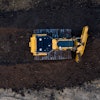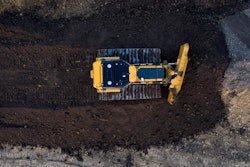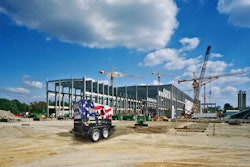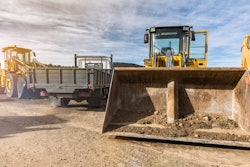
The construction industry – which has sometimes been labeled as slow to adopt technology changes – has come a long way in recent years. That outdated perception has been replaced by conversations on advanced technologies that are being used across jobsites, in equipment cabs, and in maintenance bays. Businesses in the construction space are adopting new solutions to stay competitive in the face of emerging industry standards and shifting client demands.
One example of this proliferation is in fleet management. Construction businesses, contractors, and fleet managers are increasingly using AI, IoT, and machine learning as part of connected fleet management systems to modernize their operations and boost productivity, efficiency, and sustainability. All of this, enabled by the introduction of specialized computing hardware that brings the benefits of laptops and tablets to a rugged environment.
Digital Technologies Help Maintain Machine Uptime
In construction, the adage “time is money” rings true. Owners, contractors, and fleet managers are constantly looking for solutions that can help them be more efficient. Market reports show that interest and investment in connected fleet management is increasing, as the industry looks to improve operational performance and mitigate downtime. As the global population grows and industry demands rise, connected fleet management solutions help mitigate workforce gaps, increase jobsite productivity, and improve overall operational performance.
At its core, connected fleet management is centered on integrating technology into fleet operations. By collecting data, analyzing it, and acting on it, companies can make more informed decisions and optimize fleet management. Fleet management technologies, including GPS tracking, telematics, and Advanced Driver Assistance Systems (ADAS), leverage connectivity to gather extensive data. Unlike traditional forms of fleet management that are reactive based on history, connected fleet management brings a proactive approach to operations, getting closer to real time decision making, opening the door to preventative actions that can limit or lessen the impact of potential issues.
This provides fleet owners, project managers, technicians, and site teams with the actionable insights they need to make informed decisions. Workers can also be more efficient, performing tasks that once took hours (or days) in minutes. The solutions can help workers be more productive, which helps mitigate continued gaps in the workforce.
Working Smarter With Collaborative Technologies
Connected fleet management technology is about collaboration. Across teams, industries, and platforms, at the touch of a screen or click of a track pad, these solutions capture near-infinite streams of real-time data. This data is then made accessible to decision-makers at every level and every project stage.
From any location, technicians can access maintenance logs, technical manuals, and requisition statuses that are critical to performing the job efficiently and effectively. As they manage a host of different fleet machinery, dispatchers can track operator hours, idle times, and driver distraction data from a centralized location. And, as they juggle competing priorities and balance support for multiple jobsites, project managers can monitor and adjust project timelines, resource requirements, and budgets.
Instead of working in silos, or off outdated paper, or via constant cell phone calls, connected fleet management solutions give teams the power to collaborate in new ways, while also making time to action quicker and simpler.
Giving Frontline Workers The Advanced Technology They Need
It’s easy to see how connected fleet management solutions would appeal to front office management, but they also streamline the day-to-day tasks of front-line workers who are in the field, on the road, or in the maintenance bay.
In the past, ordering repair parts required a time-consuming process that looked something like this: A mechanic would look up a part’s nomenclature in a technical manual, then use vendor catalogues to find a stock number, and then take the requisition to a middleperson for ordering. The middleperson would contact the vendor to check stock availability and place the order, if the part was available. The process would need to be repeated if parts were unavailable or had to be sourced from multiple vendors.
Connected fleet technology greatly expedites this process, as well as many other everyday construction use cases. Now, the requisition process begins and ends on the bay floor, whether that’s on-site or an outside facility. Technicians can research technical manuals, vendor catalogues, part availability, estimated shipping dates, and more – all from a rugged laptop or tablet, from wherever they are. This streamlined process is more cost-efficient and enables teams to get equipment back up and running quickly to increase employee productivity and customer satisfaction.
AI Impacts Fleet Management
Equipment and vehicle operators are charged with moving heavy machinery across long stretches of terrain. Not only do they need to do this as efficiently as possible, but they also need to do it safely. AI – and the IoT and machine learning – all play critical roles in connected fleet management solutions to increase fleet safety on jobsites, in maintenance bays, and on the road.
AI can detect potential vehicle failures that endanger operators and cause unexpected downtime. ADAS-enabled construction equipment and vehicles can also be equipped with geo-spatial fencing, automatic braking, fatigue, distraction detection, and other features to ensure the safety of equipment operators and surrounding ground crews, pedestrians, vehicles, and others.
AI and AI-enabled solutions will continue to positively impact fleet management, becoming more actionable and effective the more data it generates. From route optimization and material movement to predictive maintenance on construction machinery, this technology will permeate workflows over the next decade and beyond.
Maintaining Resilience Whatever Comes Next
Connected fleet management solutions are helping businesses be more efficient than ever, which promotes resilience and cost effectiveness during times of turbulence and uncertainty. These solutions give fleet operators and managers in the construction industry the tools they need to improve operations, shore up workflows, and take care of their drivers and vehicles. They also deliver a rapid return on investment, with AI and other advanced technologies helping companies save time and money.
Connected fleet management solutions play a pivotal role in asset visibility, machine maintenance, and jobsite resiliency. Placing the right data in the right hands at the right time, fleet management technologies can actualize positive change and improvements across various aspects of today’s jobsite through increased productivity, efficiency, and collaboration.



















